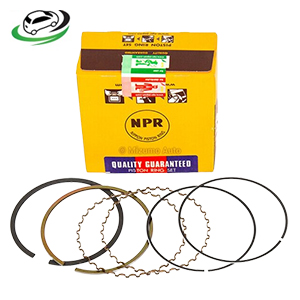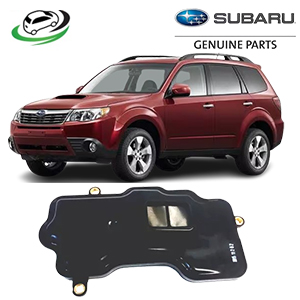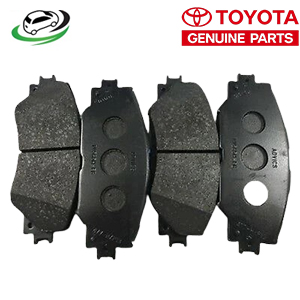Get Toyota Prius V 2012-2017 Front Brake Pad Kit 04465-42200
Front brake pad kits are crucial components of a vehicle’s braking system, directly influencing safety, performance, and overall driving experience. This detailed overview will explore the functions of brake pads, the different types available, the installation process, maintenance tips, and considerations for choosing the right kit for your vehicle.
1. What Are Front Brake Pads?
Front brake pads are friction components located within the disc brake system of a vehicle. When the driver presses the brake pedal, hydraulic pressure is applied to the brake calipers, which squeeze the brake pads against the brake rotor. This action generates friction, slowing down or stopping the vehicle. Given their critical role in safety, understanding brake pads is essential for any vehicle owner.
2. Functions of Brake Pads
The primary functions of front brake pads include:
- Friction Generation: Brake pads convert kinetic energy into heat through friction. This is essential for slowing down or stopping the vehicle effectively.
- Heat Dissipation: During braking, significant heat is generated. Brake pads help dissipate this heat, preventing brake fade, which can occur when components overheat and lose effectiveness.
- Noise and Vibration Dampening: Quality brake pads are designed to minimize noise and vibration during braking, contributing to a smoother driving experience.
- Protection of Brake Components: Brake pads act as a buffer between the brake rotor and caliper, preventing wear on these components and extending their lifespan.
3. Types of Brake Pads
Brake pads come in various materials and formulations, each with unique characteristics suited for different driving conditions. The most common types include:
- Organic Brake Pads: Made from a blend of materials such as rubber, resins, and fibers, organic pads are quieter and produce less dust. However, they wear out faster and may not perform as well under high temperatures.
- Semi-Metallic Brake Pads: These pads contain a mix of metal fibers (such as steel) and organic materials. They offer excellent heat transfer and durability, making them suitable for performance vehicles. However, they can be noisier and produce more dust than organic pads.
- Ceramic Brake Pads: Composed of ceramic fibers, non-ferrous materials, and bonding agents, ceramic pads provide excellent stopping power, low dust production, and quiet operation. They are ideal for daily drivers and offer longevity but may not perform as well in extreme conditions compared to semi-metallic pads.
- Carbon-Composite Brake Pads: These pads are designed for high-performance and racing applications, providing superior stopping power and heat resistance. They are typically more expensive and may require specialized rotors.
4. Choosing the Right Brake Pad Kit
When selecting a front brake pad kit, consider the following factors:
- Driving Style: Your driving habits significantly influence the type of brake pads you should choose. If you frequently drive in stop-and-go traffic, organic or ceramic pads may be suitable. For spirited driving or track use, semi-metallic or carbon-composite pads might be better.
- Vehicle Type: Different vehicles have different braking requirements. Performance vehicles may benefit from higher-friction pads, while everyday vehicles might perform well with standard organic or ceramic options.
- Noise Level: If noise is a concern, consider ceramic pads, as they are known for their quiet operation. Semi-metallic pads may generate more noise, particularly under hard braking.
- Dust Production: Organic and ceramic pads typically produce less brake dust compared to semi-metallic pads. If keeping your wheels clean is a priority, opt for pads with lower dust production.
- Price and Quality: While price is an important factor, investing in high-quality brake pads is essential for safety and performance. Opt for reputable brands with a track record of reliability.
5. Installation Process
Installing front brake pads involves several steps. Although some vehicle owners may choose to perform this task themselves, it’s important to follow safety precautions and consult the vehicle’s service manual. Here’s a general overview of the installation process:
Tools Needed:
- Socket wrench set
- Brake cleaner
- C-clamp or brake caliper tool
- Torque wrench
- Protective gloves and goggles
Installation Steps:
- Preparation: Park the vehicle on a level surface, engage the parking brake, and loosen the wheel lug nuts. Lift the front of the vehicle with a jack and secure it with jack stands.
- Remove the Wheel: Once the vehicle is secured, remove the wheel to access the brake components.
- Inspect the Brake Components: Before replacing the pads, inspect the brake rotors for wear or damage. If the rotors are worn beyond manufacturer specifications, they may need to be resurfaced or replaced.
- Remove the Brake Caliper: Locate the caliper mounting bolts and remove them using a socket wrench. Carefully slide the caliper off the rotor, ensuring not to stress the brake lines.
- Remove the Old Brake Pads: The old brake pads will be held in place by clips or retaining springs. Remove these components and take out the old pads.
- Compress the Caliper Piston: Use a C-clamp or brake caliper tool to compress the caliper piston back into the caliper housing. This step is crucial for making room for the new, thicker pads.
- Install New Brake Pads: Place the new brake pads into the caliper bracket. Ensure they are positioned correctly according to the manufacturer’s specifications.
- Reinstall the Brake Caliper: Carefully slide the caliper back over the new pads and rotor. Reattach the caliper mounting bolts and torque them to the manufacturer’s specifications.
- Reinstall the Wheel: Place the wheel back onto the hub, hand-tighten the lug nuts, and lower the vehicle to the ground. Once on the ground, use a torque wrench to tighten the lug nuts to the specified torque.
- Test the Brakes: Before driving, pump the brake pedal a few times to ensure proper seating of the pads against the rotors. Test the brakes at low speeds to ensure they function correctly.
6. Maintenance Tips
Proper maintenance of brake pads and the entire braking system is essential for safety and performance. Here are some tips:
- Regular Inspections: Periodically check brake pads for wear, cracks, or other damage. Most manufacturers recommend inspecting brake pads every 10,000 to 15,000 miles.
- Listen for Noises: Pay attention to unusual noises, such as squeaking or grinding, while braking. These sounds may indicate worn pads or other issues that require immediate attention.
- Monitor Brake Performance: If you notice a decrease in braking performance, such as longer stopping distances or a spongy brake pedal, have your braking system inspected by a professional.
- Avoid Riding the Brakes: Frequent or prolonged braking can cause excessive wear on brake pads. Practice smooth acceleration and deceleration to extend the life of your pads.
- Keep Brake Components Clean: Dirt and debris can accumulate on brake components, affecting performance. Regularly clean the brake area with brake cleaner to prevent buildup.
7. Signs of Worn Brake Pads
It’s essential to recognize the signs of worn brake pads early to prevent further damage to the braking system. Common indicators include:
- Squeaking or Squealing Noises: A high-pitched squeaking noise often indicates that the brake pads are worn and need replacement.
- Grinding Noises: A grinding sound occurs when the brake pads have worn down to the backing plate, leading to metal-on-metal contact. This can damage the rotors and should be addressed immediately.
- Vibration or Pulsation: If you feel vibration or pulsation in the brake pedal while braking, it may indicate warped rotors or uneven pad wear.
- Warning Light: Some vehicles are equipped with a brake wear indicator that illuminates when the pads are worn. Always heed warning lights and have the brakes inspected.
8. Conclusion
Front brake pad kits are integral to a vehicle’s braking system, ensuring safety, performance, and comfort. Understanding the functions, types, installation process, and maintenance of brake pads is essential for any vehicle owner. Regular inspections and timely replacements can significantly enhance braking performance and extend the lifespan of your vehicle’s braking system. By choosing the right brake pads for your driving style and maintaining them properly, you can ensure a safe and enjoyable driving experience. Remember, a well-maintained braking system is a key element in vehicle safety.
Follow us on Facebook for more parts.




Reviews
Clear filtersThere are no reviews yet.